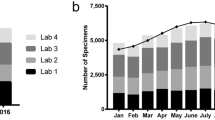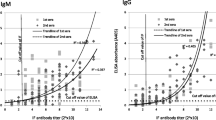Abstract
A commercially available enzyme-linked immunosorbent assay (ELISA) detecting Coxiella burnetii phase II-specific IgM for the diagnosis of acute Q fever was compared with indirect immunofluorescent antibody assay (IFA). IFA is the current reference method for the detection of antibodies against C. burnetii, but has disadvantages because the judgment of fluorescence is subjective and tiring, and the test is expensive and automation is not possible. To examine whether phase II IgM ELISA could be used as a screening assay for acute Q fever, we compared the sensitivity and specificity of IFA and ELISA. The sensitivity of the IFA and ELISA tests were 100 and 85.7%, respectively, with a specificity of 95.3 and 97.6%, respectively. Because of the high sensitivity and specificity of the ELISA in combination with the practical disadvantages of the IFA, we introduced a new algorithm to screen samples of patients with symptoms of acute Q fever infection.

Similar content being viewed by others
References
Raoult D, Marrie TJ, Mege JL (2005) Natural history and pathophysiology of Q fever. Lancet Infect Dis 5:219–226
Fournier PE, Marrie TJ, Raoult D (1998) Diagnosis of Q fever. J Clin Microbiol 36:1823–1834
Dupuis G, Péter O, Peacock M, Burgdorfer W, Haller E (1985) Immunoglobulin responses in acute Q fever. J Clin Microbiol 22:484–487
Péter O, Dupuis G, Bee D, Lüthy R, Nicolet J, Burgdorfer W (1988) Enzyme-linked immunosorbent assay for diagnosis of chronic Q fever. J Clin Microbiol 26:1978–1982
Schneeberger PM, Hermans MHA, van Hannen EJ, Schellekens JJA, Leenders ACAP, Wever PC (2010) Real-time PCR with serum samples is indispensable for early diagnosis of acute Q fever. Clin Vaccine Immunol 17(2):286–290
Schimmer B, Dijkstra F, Vellema P, Schneeberger PM, Hackert V, ter Schegget R, Wijkmans C, van Duynhoven Y, van der Hoek W (2009) Sustained intensive transmission of Q fever in the south of the Netherlands, 2009. Euro Surveill 14(19):pii=19210. Available online at: http://www.eurosurveillance.org/ViewArticle.aspx?ArticleId=19210
Jager MM, Weers-Pothoff G, Hermans MHA, Meekelenkamp JCE, Schellekens JJA, Renders NHM, Leenders ACAP, Schneeberger PM, Wever PC (2011) Evaluation of a diagnostic algorithm for acute Q fever in an outbreak setting. Clin Vaccine Immunol 18(6):963–968
Field PR, Mitchell JL, Santiago A, Dickeson DJ, Chan SW, Ho DWT, Murphy AM, Cuzzubbo AJ, Devine PL (2000) Comparison of a commercial enzyme-linked immunosorbent assay with immunofluorescence and complement fixation tests for detection of Coxiella burnetii (Q fever) immunoglobulin M. J Clin Microbiol 38:1645–1647
Author information
Authors and Affiliations
Corresponding author
Rights and permissions
About this article
Cite this article
Meekelenkamp, J.C.E., Schneeberger, P.M., Wever, P.C. et al. Comparison of ELISA and indirect immunofluorescent antibody assay detecting Coxiella burnetii IgM phase II for the diagnosis of acute Q fever. Eur J Clin Microbiol Infect Dis 31, 1267–1270 (2012). https://doi.org/10.1007/s10096-011-1438-0
Received:
Accepted:
Published:
Issue Date:
DOI: https://doi.org/10.1007/s10096-011-1438-0




